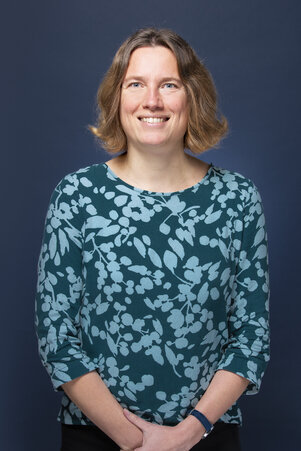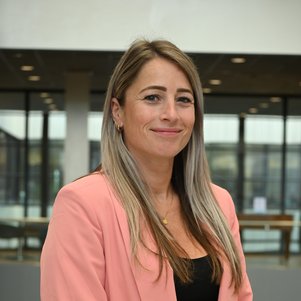Prof.dr. Gijsje Koenderink
Research Theme(s): Synthetic biology and Cell biology
Research Interests: cell mechanics, tissue mechanics, active soft matter, cytoskeleton, extracellular matrix, mechanobiology, tissue (re)generation
Biography
Prof. Dr. Gijsje Koenderink (1974) is full professor in the Bionanoscience Department of the TU Delft. She obtained a MSc (cum laude, 1998) and Ph.D. (cum laude, 2003) in Chemistry at Utrecht University and trained as a Marie Curie postdoctoral Fellow at the VU University Amsterdam (2003-2004) and Harvard University (2004-2006). In 2006 she established the Biological Soft Matter group at the NWO Institute AMOLF, where she also headed the Living Matter Department (2014-2019). Koenderink’s group focuses on quantitative experimental studies of the material properties of cells and tissues. She combines bottom-up synthetic biology approaches with multiscale physical characterization from single molecule force spectroscopy to rheometry. Her group closely collaborates with biological and biomedical groups to address the role of cell and tissue mechanics in disease and tissue regeneration. Prof. Koenderink received various distinctions, including an NWO VIDI (2008), elected membership of the Young Academy of the KNAW (2008), ERC Starting Grant (2013), NWO VICI (2019) and the P-G. de Gennes Prize (2018), and she is a co-recipient of the NWO-Gravitation program Basyc (2017-2027).
For further information regarding current research and available projects, visit Koenderink lab.
Courses
From 2006 until 2019, I worked as a full-time scientific group leader at the NWO Institute AMOLF in Amsterdam. During this period I have taught invited M.Sc. & B.Sc. lectures in biophysics at Wageningen University, Utrecht University, Vrije Universiteit Amsterdam, University of Amsterdam, Amsterdam University College, ErasmusMC, Radboud University Nijmegen, and invited PhD courses in biophysics & cell biology at the TU Dresden, Physikzentrum Bad Honnef, Les Houches, St Catherine’s College Oxford UK, Forschungszentrum Jülich, EMBL Heidelberg, and Corsica.
TUD: BSc Course Nanotechnology (2019)
Current Projects
- Design principles for resilient bacterial membranes (MEP): Cells can cope with large external mechanical stresses even though the cellular envelope, the plasma membrane, is very soft and only of molecular thickness. Many organisms have adapted protective mechanisms that mechanically strengthen the cellular container. Bacterial cells for instance have a rigid cell wall which protects the cell from the outside. An open question is how these intra- and extracellular fortification strategies change the mechanical requirements for the plasma cell membrane itself. You will measure the mechanical properties of the bacterial cell membrane using membranes rebuilt from purified components and spheroplasts that comprise an intact bacterial membrane, with a technique called micropipette aspiration.
<u5:p></u5:p> - The remarkable molecular architecture of the Archaeal cell envelope (MEP): Archaea are a unique class of organisms that enjoy living in environments that are very saline, acidic, or extremely hot. An example is Sulfolobus acidocaldarius that has an optimal growth temperature around 80°C. S. acidocaldarius makes clever use of uncommon membrane building blocks that are extremely resilient to high temperatures known as bolalipids, which are tetrather phospholipids. You will explore the effect of the presence of bolalipids on membrane elasticity using cell-like vesicles reconstituted from the archaeal lipids and optical tweezers, fluorescence recovery after photobleaching and micropipette aspiration.
<u5:p></u5:p> - Overcoming the hurdle in bottom-up synthetic cell biology (BEP): Understanding cellular life is one of the key scientific challenges in the 21st century. While biology used to be a descriptive discipline, this century brings about a new approach: bottom-up synthetic biology. A major challenge in this field remains to recreate cell-like compartments, which we call vesicles, that encapsulate components of interest, such as proteins. In this project, you will use a technique called pendant drop to study how proteins interact in the vesicle formation process. Since the vesicle formation processes typically happen at water-oil interfaces, you will investigate how proteins and lipids competitively adsorb onto these interfaces. Ultimately, you will explore methods to boost vesicle formation processes in the presence of cytoskeletal proteins, such that we can take bottom-up synthetic biology one step further.
<u5:p></u5:p> - Teamwork in active cytoskeletal systems (MEP): The cells in our body are highly complex, soft and responsive machines thanks to their cytoskeleton: a composite material of three different filamentous proteins, microtubules, actin, and intermediate filaments. Our group uses experimental studies on minimal in-vitro reconstituted systems to investigate the mechanisms of mechanical integration in the cytoskeleton. You will examine how actin and intermediate filaments team up to allow the cell to change its shape from the inside, while not giving in to external stresses. To this end, you will study mechanics and contractility of minimal cytoskeletal systems reconstituted from purified cytoskeletal components using time-lapse confocal microscopy.
<u5:p></u5:p> - Using nanoparticles to put tension on artificial cells (MEP): Cell division in animal cells requires the force-generating actin cytoskeleton to work together with the cell membrane, which should ultimately be constricted in the plane of division. In our group, we use animal cells as an inspiration for implementing a minimal cell-division machinery in a synthetic cell. This project aims at establishing a novel method of physically connecting cytoskeletal filaments to cell membranes, using the tools of modern nanoparticle synthesis. You will establish a novel nanoparticle-based system to mimic the large protein complexes which mediate actin-membrane interactions in natural cells. You will experiment with surface chemistry and physical characteristics of both commercial and custom-synthesized nanoparticles to optimize their suitability for both protein binding and membrane insertion. To characterize the system, you will use spectrophotometry and advanced microscopy techniques such as confocal fluorescence microscopy and electron microscopy.
<u5:p></u5:p> - A fresh look at a well-known motor (MEP): Molecular motors are crucial components of our body: they make our muscles contract, they transport cargo through our cells, and they provide the forces needed to divide a cell. Some motor proteins act alone, but some of the most ubiquitous motor proteins act as collectives of multiple motor proteins. The aim is to study myosin motors, the motor proteins which drive remodeling of the actin cytoskeleton. You will reconstitute myosin motor assemblies and study their structure and function using electron and fluorescence microscopy and optical tweezers.
<u5:p></u5:p> - Regulating a multi-functional cytoskeletal protein (MEP/BEP): Human cells rely on their actin cytoskeleton for many functions: Cell division, mobility, and even mechanical protection from the forces their environment exerts on them. With this project, you will be laying the groundwork for reconstituting dynamic actin cortices inside synthetic cells. You will purify recombinant actin regulatory proteins. You will use fluorescence spectrophotometry to characterize the functionality of these proteins and assess the effect they have on the dynamic properties of actin. Finally, you will combine the proteins in a cell-free in vitro reconstituted system to build a minimal dynamic actin cortex. You will study such minimal cortices using TIRF microscopy and, depending on your interests, also characterize their mechanical properties.
<u5:p></u5:p> - Mimicking septin cages (MEP): Recently, septins have been discovered as the fourth component of the cytoskeleton of human cells. Septins are proteins essential for fundamental cellular processes, like cell division, host-pathogen interactions, vesicle trafficking and many other cellular functions. Along its many functions, septins have been also recently found to act as part of the innate immune system: a recent discovery showed that the protein is able to bind the poles of certain pathogens, forming a cage around the growing bacteria which inhibits its division. The goal is to mimic septin cage formation in a cell-free manner to study the nature of the interactions of septin with the poles of the pathogens and understand, in a minimal system, the formation of the septin cage. You will first implement a microfluidic system to deform liposomes, minimal models of the cell membrane, into bacteria-like shapes. With this system, we will first study how PIP2 and cardiolipin, the lipids responsible for the septin interaction with the membrane, distribute on the liposomes. Finally you will study the spatial arrangement and the dynamics of the septin structures reconstituted on the membrane of elongated liposomes.
<u5:p></u5:p> - Human septin octamer polymerization (BEP): Recently septins have been discovered as the fourth component of the human cytoskeleton. Septins are essential for cell division, host-pathogen interactions, vesicle trafficking and many other cellular functions. Vital for these functions is their ability to form higher order structures such as filaments, bundles, rings, and meshes that are able to interact with the cell membrane, microfilaments and microtubules. In humans, cells contain four subfamilies of septins that can form functional hexamers or octamers in a combinatorial fashion. These oligomers are then the building block to form the apolar filaments and higher order structures. Tthe goal is to study the mechanism by which human septin octamers polymerize and interact with the cell membrane. You will purify recombinant septins and study their polymerization behavior in solution by fluorescence and electron microscopy. Next, you will study septin interactions with the cell membrane by polymerizing septin octamers on top of supported lipid bilayers and/or giant unilamellar vesicles of different lipid compositions.
<u5:p></u5:p> - Cytoskeletal crosstalk between septins and microtubules (MEP): Traditionally, the cytoskeleton of mammalian cells is thought to consist of 3 filament types known as microfilaments, microtubules and intermediate filaments. However, recently septins have been discovered as the fourth component of the cytoskeleton. In humans, cells contain four subfamilies of septins that can form functional hexamers or octamers in a combinatorial fashion. These oligomers are then the building block to form the apolar filaments and higher order structures. Recent studies show that septins interact with microtubules. Specially, human septin octamers containing septin 9_i1, which are overexpressed in many cancers, have been found to regulate microtubules plus end dynamics. The goal is to study the interaction of human septin octamers and microtubules. You will purify recombinant septins and polymerize them in vitro in the presence of growing microtubules to see the effect on septin polymerization and on the dynamics of microtubules in the presence and absence of EB1. You will compare the impact of human septin hexamers and octamers containing either septin i1 or i3. Towards the end, you will extend the assay towards a more physiological context by adding supported lipid bilayers containing septin interacting lipids to account for the influence of the cell membrane.
Highlight Publications
1. F. Burla, Y. Mulla, B.E. Vos, A. Aufderhorst-Roberts, G.H. Koenderink, From mechanical resilience to active material properties in biopolymer networks, Nature Physics Reviews 1, 249–263 (2019)
2. F. Burla, J. Tauber, S. Dussi, J. van der Gucht, G.H. Koenderink, Stress management in composite biopolymer networks, Nature Physics 15: 549–553 (2019)
3. M. Dogterom, G.H. Koenderink, Actin–microtubule crosstalk in cell biology, Nature Reviews Molecular Cell Biology 20, 38-54 (2019)
4. J. Alvarado, M. Sheinman, A. Sharma, F.C. MacKintosh, G.H. Koenderink, Force percolation of contractile active gels, Soft Matter, 13(24): 5624-5644 (2017)
5. F Huber, A Boire, MP Lopez, GH Koenderink, Cytoskeletal crosstalk: when three different personalities team up, Current Opinion in Cell Biology 32, 39 (2015)

